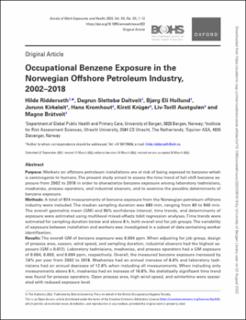| dc.description.abstract | Purpose
Workers on offshore petroleum installations are at risk of being exposed to benzene which is carcinogenic to humans. The present study aimed to assess the time trend of full-shift benzene exposure from 2002 to 2018 in order to characterize benzene exposure among laboratory technicians, mechanics, process operators, and industrial cleaners, and to examine the possible determinants of benzene exposure.
Methods
A total of 924 measurements of benzene exposure from the Norwegian petroleum offshore industry were included. The median sampling duration was 680 min, ranging from 60 to 940 min. The overall geometric mean (GM) and 95% confidence interval, time trends, and determinants of exposure were estimated using multilevel mixed-effects tobit regression analyses. Time trends were estimated for sampling duration below and above 8 h, both overall and for job groups. The variability of exposure between installation and workers was investigated in a subset of data containing worker identification.
Results
The overall GM of benzene exposure was 0.004 ppm. When adjusting for job group, design of process area, season, wind speed, and sampling duration, industrial cleaners had the highest exposure (GM = 0.012). Laboratory technicians, mechanics, and process operators had a GM exposure of 0.004, 0.003, and 0.004 ppm, respectively. Overall, the measured benzene exposure increased by 7.6% per year from 2002 to 2018. Mechanics had an annual increase of 8.6% and laboratory technicians had an annual decrease of 12.6% when including all measurements. When including only measurements above 8 h, mechanics had an increase of 16.8%. No statistically significant time trend was found for process operators. Open process area, high wind speed, and wintertime were associated with reduced exposure level.
Conclusions
An overall increase in measured exposure was observed from 2002 to 2018. The increase may reflect changes in measurement strategy from mainly measuring on random days to days with expected exposure. However, the time trend varied between job groups and was different for sampling duration above or below 8 h. Industrial cleaners had the highest exposure of the four job groups while no differences in exposure were observed between laboratory technicians, mechanics, and process operators. The design of the process area, job group, wind speed, and season were all significant determinants of benzene exposure. | en_US |

